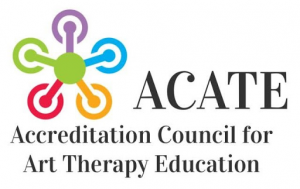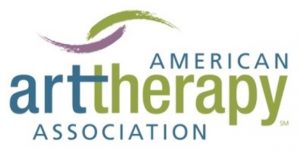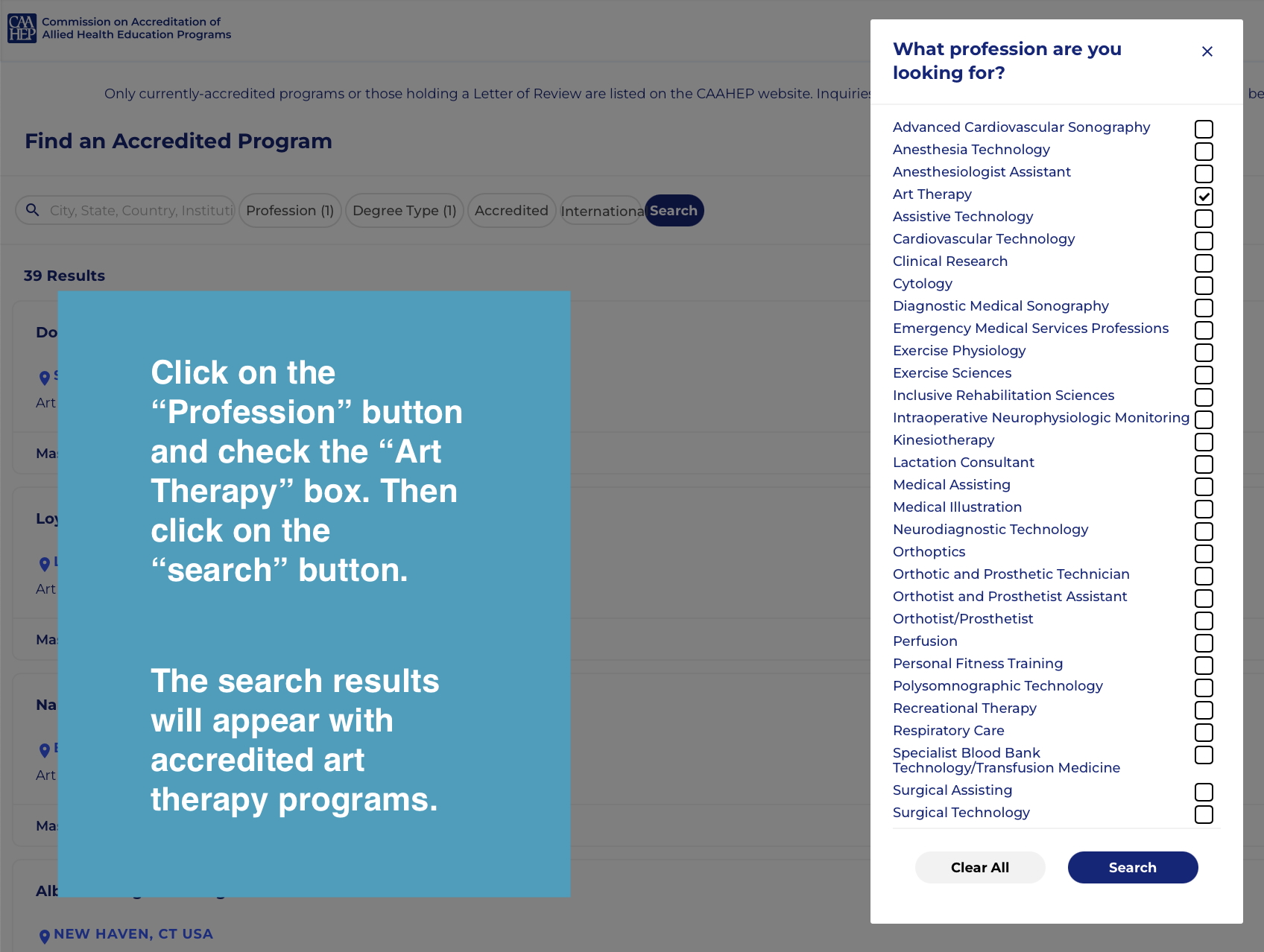This FAQ sheet has been created in response to the most frequent questions about art therapy education. It addresses answers to questions about many levels of preparation and education, from undergraduate through master’s and on to credentialing.
I Want to Become an Art Therapist! How do I Know What Education I Need?
The American Art Therapy Association (AATA) and the Accreditation Council for Art Therapy Education (ACATE) get asked this question a lot. Here are the most frequently asked questions we receive, below. (This is also available in PDF here.)


Most Frequently Asked Questions
Do I have to have an undergraduate art therapy major to apply to grad school?
It is important you know that a master’s degree is the required entry level into art therapy work. The undergraduate pre-art therapy majors or classes which exist are pre-professional and prepare students in terms of lowering anxiety and providing foundational information, but are not required to apply to graduate school.
But you have a number of options for preparatory studies. While a graduate program degree is required for art therapy work, there are many options for undergraduate preparation studies. You could choose an undergraduate pre-professional art therapy major, a double major in art and psychology, a major in art with minor in psychology, a major in psych with a minor in art, any relevant major with elective coursework in studio art and psychology, or other majors, minors or classes that would be highly applicable and still allow you to get the needed prerequisites in to apply to the graduate programs.
In terms of art therapy pre-professional majors offered across the country, a few, though not all, are listed on the AATA website. You might also google for the information. Since the focus of art therapy work is on graduate studies, a complete list of institutions that offer the undergraduate pre-professional major does not exist and as stated above, while that major is helpful, there are a number of other options for your preparatory studies as well.
What prerequisites do I need to apply to a graduate program?
Each graduate program institution establishes its own acceptance criteria but in general, programs require as prerequisites: 18 credits of studio art with a class in drawing, painting, and 3-D art media (which may include clay, 3D methods, or sculpture). The additional 9 credits of studio work then would be in other media or advanced studies in the above media, as a variety of art materials experience is needed in our client work. We need to be able to fully understand what it feels like to make art, and to express oneself in a wide variety of materials.
Graduate programs will require, as part of their application, a portfolio of artwork completed as part of prerequisite studio art coursework. Many people wonder how many pieces and what kind of work they should include. While each program will have instructions on their website, the general range tends to be around 13 pieces, in drawing, painting, 3-D media and a self-chosen variety of additional media you have explored. An artist statement that reflects the ways artmaking has fostered personal growth is also often requested.
In addition to studio art, some foundational knowledge of psychology and related fields, as pertaining to human development or varying perspectives in psychology, including related disciplines, is required. Each graduate program website will list what their prerequisite requirements are for this area, but they generally are 6-9 credits and tend to include courses with content like abnormal psychology, developmental psychology and even related disciplines such as sociology. Many types of courses can be a helpful supplement if they teach you about people, working with them, and studying their needs.
What types of courses are typically in a graduate degree in art therapy?
Art therapy has historically been referred to as an integrative profession with coursework from what is known as related mental health professions being combined with coursework taught by board-certified art therapists and which focuses on art therapy theories and methods. Art therapy education is equivalent to education in related mental health professions.
In addition, graduate programs pay attention to curriculum content requirements delineated by the Art Therapy Credentials Board (ATCB) and also by any from the state licensing boards. While each art therapy program has its own unique coursework that highlights the expertise of its faculty or needs of the region it is located in, the following content areas reflect the types of coursework typically in a graduate degree in art therapy. Note these are content areas, not course titles, so when reviewing a program you might see, in its class list, a different course title for what essentially covers the following content areas:
- Psychopathology
- Psychological Assessment
- Human Growth and Development
- Counseling/Psychological Theories
- Helping Relationships
- Research
- Vocational and Career Development
- Professional Orientation Ethical and Legal Issues
- Multicultural/Cultural Humility and Social Issues
- History and Theory of Art Therapy
- Materials and Techniques of Practice in Art Therapy
- Creativity Studies
- Studio Art
- Application of Art Therapy with People in Different Treatment Settings
- Art Therapy Assessment
- Group Art Therapy
- Culminating Thesis or Project
- Practicum and Internship
Programs may also have coursework that highlights Family Therapy studies, Trauma studies, Studies in Addiction Recovery, Studies in related Creative Arts Therapies such as Drama Therapy or Dance-Movement Therapy, additional Studio electives, Medical Art Therapy, etc. depending on the requirements of their state for state licensure, the expertise of their faculty, or needs of the region they are located in.
What state should I go to school in?
This is an important question for graduate studies. An undergraduate student can really study anywhere in the country. For a master’s program though, at this time the best place to attend graduate studies depends in large part on where you might want to live and settle once working. The reason for that is that each state has its own regulations for what classes need to be taken to go on and become a licensed mental health provider. There is a lot of overlap between state requirements, but some states have an art therapy license (and lots of people are working hard to have more states that offer that.) Some states at this time just offer an option for a Counseling License or, more rarely, a license in Marriage and Family Therapy.
Each program develops its classes to meet the requirements of whatever state it is in so its graduates can go on and become licensed in that state, though most programs also include the classes needed by many other states as well.
So what to do? We wish there was an easy answer for this but the best thing to do is to reach out to the programs and ask them if they will prepare you for licensure in the state you want to work in. If you aren’t sure where you want to live (which keeps life interesting) the honest thing we suggest is that you choose a school you are drawn to, and trust that wherever you are meant to be in the future will open to you. Some things in life you just can’t plan for sure. Our work in art therapy requires us to be very flexible and to not always know exactly how things will turn out with clients, and that is often the best attitude to take when figuring out where to study as well. Choose a program that will help you grow.
I want to become a certified art therapist.
There are a couple of terms that are important to define: a) Board Certification b) Art Therapy Credentials Board c) Licensure d) Accredited.
While the master’s degree is the required entry level of art therapy, after graduating people can start by becoming provisionally registered as an art therapist (ATR-P) then spend a few more years of work and go on to become a “Board-Certified Art Therapist” (ATR-BC).
The pathways to becoming board certified are overseen by the Art Therapy Credentials Board (ATCB) and it’s important you ask them any questions you have about pathways for becoming “registered then board-certified”.
It’s important to know
these terms:
Board Certification
Art Therapy Credentials Board (ATCB)
Licensure
Accredited
Having written that, most graduate programs will want their students to have the courses needed, so you could ask a program you are applying to if the courses they offer will prepare you to go on to apply to be board-certified. Most, if not all, will. Being able to put ATR-P, then ATR, then ATR-BC after your name shows you are highly trained and competent.
The next term is about becoming “licensed,” which is different from becoming board-certified. See the explanation of state mental health licenses in the answer above where we discuss what state to go to school in, and why that might matter (or not). State Licensure as a mental health provider is a second level that is achieved in addition to becoming board-certified. Depending on the state you are living and working in, or the kind of work you want to do, it may be important to eventually become both board certified and licensed. A lot of people tell us this all seems like such a long process! That’s an exciting part of our work though, it keeps us growing, and there is always something new to learn. Think of it as a vocation, a calling, not just a job.
Finally, let’s talk about the term “accredited.” We get a lot of questions from people saying they want to be an accredited art therapist. That is a slight confusion of terms. What they really are asking about is how they can become a board-certified art therapist and licensed mental health provider. The term “accredited” applies to the graduate education programs. An education program can be accredited, not a person.
I already have a master’s degree in a related mental health field. Can I become certified as an art therapist without a whole second master’s degree?
It depends on what courses and content have been a part of your initial master’s degree. It is also important to remember that the Art Therapy Credentials Board (ATCB) is the organization that oversees credentialing of individuals (while ACATE oversees the quality of the education programs).
Generally, there are several options for individuals with a prior related master’s degree to also study art therapy and become board certified. One is to enroll in a graduate art therapy program under their “Post-Master’s Masters” degree option. This may also be referred to as “Advanced Standing”. Many if not most of your prior classes in your initial degree may apply to the new studies and you would not have to repeat some course content, though you would need to take courses required to be taught by art therapists. Each graduate program advertises whether or not they offer this option on its website.
Art Therapy Credentials Board (ATCB):
the organization that oversees credentialing of individuals
Accreditation Council for Art Therapy Education (ACATE):
the organization that oversees the quality of education programs
Additionally, some programs offer an art therapy certificate option which consists of taking classes and completing post-grad work hours, but not earning a second master’s degree. Additional hours of post-grad supervised employment are required under this certificate option. The Art Therapy Credentials Board can answer questions about the art therapy certificate option, while it is also important to understand that art therapy board certification can also be achieved through a post-master’s masters/advanced standing housed within an art therapy program. Questions on these scenarios are best directed to ATCB. Each individual graduate program may also be able to answer questions about a post-master’s master’s option if they offer it.
Where can I find a list of master’s art therapy programs?
There are few things to know about this answer.
a) A link to “Find an Accredited Program” can be found on the ACATE website. Quality art therapy programs undergo a rigorous accreditation review process which ensures their resources, curriculum, faculty and policies are prepared to meet your learning needs. You can learn more about the benefits of attending an accredited program on the website.
b) Keep in mind that a program may be so new that it is not yet able to apply to be part of the accredited list. Newer programs can be quality as well, so feel free to do your research and explore the programs listed on the directories along with any that you might locate that may be newer and not yet on the directory list.
I want an online program because I can’t move.
If your life does not allow you to immerse yourself in a new setting by moving to a school program, it’s important to know that there are some options to consider. “Fully online” or “low-residency” or even “hybrid” are the sorts of program designs that may offer you a livable option.
When looking at the directory of art therapy programs, review ALL the art therapy profession programs websites to see what ones offer an in-person, fully online, or low-residency component. Online education can occur with all classes online or with the classes mostly online but only one to three weeks back on campus a year such as with the low-residency option. In-person programs have a lot to offer as well, if you can move or live nearby.
Each master’s program website will show what options exist for your studies and since programs are always developing new ideas, it is essential you research each program, and how it is designed. That is more work for you, but actually increases your options.
Full Onsite (In-Person) Delivery: Instruction is provided on campus, where instructors and students interact simultaneously in the same physical location. Internship experiences are completed within the region where the school is located.
Full Distance Education/Online Delivery: Instruction is provided through synchronous or asynchronous methods where the instructor and student are physically separated and using technology to interact. Internship experiences are completed in the student’s home community.
Hybrid or Low Residency Delivery: Instruction is provided using a combination of onsite (in-person) and distance education instruction, which may be synchronous or asynchronous. This method includes low-residency, which involves some amount of distance education and brief on-campus residencies which may be one weekend or several weeks. Internship experiences are completed in the student’s home community
Should I go to an Art Therapy program that also offers counseling, a Counseling program that also offers art therapy, a Family Therapy program that offers art therapy, or something else?
Here’s the thing, the title of any degree a program offers isn’t something to really worry about. The title of a degree a program offers is established by the program for reasons more related to the state they are in, and planning they need to do in response. That’s something the program directors and faculty have to think about. What is really more important for you is what classes the program offers. You want to look at their list of classes, not the title of the degree, because the classes are what prepare you to go on to become board-certified and licensed.
So, on this item we are going to finally have a straightforward answer, and not one super complicated! Art therapy programs, whatever the title of the degree they offer is, offer classes that teach about art-based approaches, and classes that teach about what is more often thought of as traditional mental health content. BUT IT’S ALL ART THERAPY.
To be an art therapist, I need to know how to engage in the relational therapeutic process and use art materials within that.
In the past, we used to call some of those skills “related mental health” and some “art therapy” but now it all falls under a set of skills any art therapist needs. So whatever the title of the degree, whether the first word is art therapy, or counseling, or MFT, the classes taken together will teach you to work with people and use artmaking to do it. Look at the list of classes they offer, and use that as part of your decision, not the title of the degree they offer.
In addition to foundational coursework, what else can I do to prepare for graduate school?
A favorite story the writer of this FAQ page likes to tell is that the undergraduate class that in many ways most prepared her to become an art therapist was Astronomy. The class taught her to look up and around with wonder and curiosity, and to hear stories in the stars all around, and this open attitude fosters responsive therapeutic relationships as well. Consider all the ways life and learning can teach you to notice beauty and growth and awe, even as you consider the following activities as well:
a) Engage in art-making for your own means of self-exploration and expression.
b) Show you have a desire to work with people by volunteering or working with a human service, medical, educational or similar agency offering support to community members. Some college programs even offer therapeutic art making practicum classes or internships/fieldwork at the undergraduate level that provides an opportunity for a student to work with participants and get a better understanding of what it entails. These are very basic assisting type jobs. Master level programs often want to know if the student has volunteer experience and some basic knowledge of working with children or adults and if it is something they want to pursue. Fieldwork experiences, participating in service learning, volunteer or work experience allows students to gain experience and determine if this is the career for them.
c) Participate in your own personal therapy (not necessarily art therapy if unavailable) to develop self-awareness while getting a sense of what a therapeutic relationship is like.


